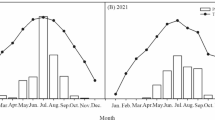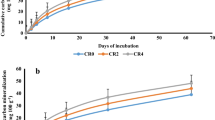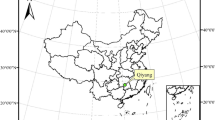Abstract
Soil aggregates govern soil organic carbon (SOC) sequestration. But, sparse understanding about the process leads to inaccuracy in predicting potential of soil to stabilize C in warming world. We appraised effects of 43 years of fertilization on relative temperature sensitivity of SOC decomposition (Q10) in soil aggregates to know whether SOC quality or quantity governs Q10. Treatments were: fallow, control, 100% recommended dose of nitrogen (N), N and phosphorus (NP), N, P and potassium (NPK), and NPK + farmyard manure (FYM) (NPK + FYM). Macroaggregates, microaggregates and silt + clay (s + c) fractions were incubated for 16 weeks at 25, 35 and 45 °C, SOC quality (R0) and Q10 were computed. SOC mineralization from macro- and micro- aggregates were 34 and 28% higher than s + c across the treatments. The s + c fraction of NPK + FYM had ~ 41, 40 and 24% higher C decay rate than NPK plots at 25, 35 and 45 °C, respectively. For s + c fraction Q10 increased over other aggregates. Mean Q10 of s + c fraction was ~ 18.3 and 17.5% higher than macro and micro-aggregate-C, respectively. R0 was the lowest for NPK + FYM, suggesting long-term manuring with balanced NPK significantly enhance recalcitrance of C. We observed Q10 of macroaggregates and s + c fraction is controlled by C quality but C quantity governs Q10 of microaggregates in Vertisol. Specifically, microaggregates of NPK + FYM were more temperature sensitive, and could be vulnerable to C loss. Hence, practices facilitating microaggregate formation should be avoided. Thus, we recommend manure application for facilitating C sequestration.





Similar content being viewed by others
References
Beauregard MS, Hamel C, St-Arnaud M (2010) Long-term phosphorus fertilization impacts soil fungal and bacterial diversity but not AM fungal community in alfalfa. Microbial Ecol 59:379–389. https://doi.org/10.1007/s10533-017-0409-7
Bhardwaj AK, Rajwar D, Mandal UK, Ahamad S, Kaphaliya B, Minhas PS, Prabhakar M, Banyal R, Singh R, Chaudhari SK, Sharma PC (2019) Impact of carbon inputs on soil carbon fractionation, sequestration and biological responses under major nutrient management practices for rice-wheat cropping systems. Sci Rep 9(1):1–10
Bhattacharyya R, Kundu S, Srivastva AK, Gupta HS, Prakash V, Bhatt JC (2011) Long term fertilization effects on soil organic carbon pools in a sandy loam soil of the Indian sub-Himalayas. Plant Soil 341:109–124. https://doi.org/10.1007/s11104-010-0627-4
Bhattacharyya R, Tuti MD, Bisht JK, Bhatt JC, Gupta HS (2012) Conservation tillage and fertilization impacts on soil aggregation and carbon pools in the Indian Himalayas under an irrigated rice-wheat rotation. Soil Sci 177:218–228. https://doi.org/10.1097/ss.0b013e3182408f1e
Bhattacharyya R, Pandey SC, Bisht JK, Bhatt JC, Gupta HS, Tuti MD, Mahanta D, Mina BL, Singh RD, Chandra S, Srivastva AK (2013) Tillage and irrigation effects on soil aggregation and carbon pools in the Indian sub-Himalayas. Agron J 105:101–112. https://doi.org/10.2134/agronj2012.0223
Billings SA, Gaydess EA (2008) Soil nitrogen and carbon dynamics in a fragmented landscape experiencing forest succession. Landsc Ecol 23:581–593. https://doi.org/10.1007/s10980-008-9218-7
Blanco-Canqui H, Lal R (2004) Mechanisms of carbon sequestration in soil aggregates. CRC Crit Rev Plant Sci 23:481–504. https://doi.org/10.1080/07352680490886842
Bosatta E, Ågren GI (1999) Soil organic matter quality interpreted thermodynamically. Soil Biol Biochem 31:1889–1891. https://doi.org/10.1016/S0038-0717(99)00105-4
Bowden RD, Davidson E, Savage K, Arabia C, Steudler P (2004) Chronic nitrogen additions reduce total soil respiration and microbial respiration in temperate forest soils at the Harvard Forest. Forest Ecol Manag 196:43–56. https://doi.org/10.1016/j.foreco.2004.03.011
Bunnell FL, Tait DE, Flanagan PW, Van Clever K (1977) Microbial respiration and substrate weight loss. I: A general model of the influences of abiotic variables. Soil Biol Biochem 9:33–40. https://doi.org/10.1016/0038-0717(77)90058-X
Cambardella CA, Elliott ET (1993) Carbon and nitrogen distribution in aggregates from cultivated and native grassland soils. Soil Sci Soc Am J 57:1071–1076. https://doi.org/10.2136/sssaj1993.03615995005700040032x
Casida LE Jr, Klein DA, Santoro T (1964) Soil dehydrogenase activity. Soil Sci 98:371–376
Cheshire MV, Mundie CM (1966) The hydrolytic extraction of carbohydrates from soil by sulphuric acid. J Soil Sci 17:372–381
Colman BP, Schimel JP (2013) Drivers of microbial respiration and net N mineralization at the continental scale. Soil Biol Biochem 60:65–76. https://doi.org/10.1016/j.soilbio.2013.01.003
Conant RT, Ryan MG, Ågren GI, Birge HE, Davidson EA, Eliasson PE, Evans SE, Frey SD, Giardina CP, Hopkins FM, Hyvönen R (2011) Temperature and soil organic matter decomposition rates-synthesis of current knowledge and a way forward. Glob Chang Biol 17:3392–3404. https://doi.org/10.1111/j.1365-2486.2011.02496.x
Cotrufo MF, Wallenstein MD, Boot CM, Denef K, Paul E (2013) The microbial efficiency-matrix stabilization (MEMS) framework integrates plant litter decomposition with soil organic matter stabilization: do labile plant inputs form stable soil organic matter? Glob Chang Biol 19:988–995. https://doi.org/10.1111/gcb.12113
Craine JM, Morrow C, Fierer N (2007) Microbial nitrogen limitation increases decomposition. Ecology 88:2105–2113. https://doi.org/10.1890/06-1847.1
Craine JM, Fierer N, McLauchlan KK (2010) Widespread coupling between the rate and temperature sensitivity of organic matter decay. Nat Geosci 3:854. https://doi.org/10.1038/ngeo1009
Dai X, Ouyang Z, Li Y, Wang H (2013) Variation in yield gap induced by nitrogen, phosphorus and potassium fertilizer in North China plain. PLoS ONE 8:e82147. https://doi.org/10.1371/journal.pone.0082147
Davidson EA, Janssens IA (2006) Temperature sensitivity of soil carbon decomposition and feedbacks to climate change. Nature 440:165–173. https://doi.org/10.1038/nature04514
Davidson EA, Janssens IA, Luo Y (2006) On the variability of respiration in terrestrial ecosystems: moving beyond Q10. Glob Chang Biol 12:154–164. https://doi.org/10.1111/j.1365-2486.2005.01065.x
Davidson EA, Samanta S, Caramori SS, Savage K (2012) The dual Arrhenius and Michaelis-Menten kinetics model for decomposition of soil organic matter at hourly to seasonal time scales. Glob Change Biol 18:371–384. https://doi.org/10.1111/j.1365-2486.2011.02546.x
Ding J, Chen L, Zhang B, Liu L, Yang G, Fang K, Chen Y, Li F, Kou D, Ji C, Luo Y (2016) Linking temperature sensitivity of soil CO2 release to substrate, environmental, and microbial properties across alpine ecosystems. Glob Biogeochem Cycl 30:1310–1323. https://doi.org/10.1002/2015GB005333
Eivazi F, Tabatabai MA (1988) Glucosidases and galactosidases in soils. Soil Biol Biochem 20:601–606. https://doi.org/10.1016/0038-0717(88)90141-1
El Fels L, Lemee L, Ambles A, Hafidi M (2014) Identification and biotransformation of lignin compounds during co-composting of sewage sludge-palm tree waste using pyrolysis-GC/MS. Int Biodet Biodegrad 92:26–35. https://doi.org/10.1016/j.ibiod.2014.04.001
Fierer N, Allen AS, Schimel JP, Holden PA (2003) Controls on microbial CO2 production: a comparison of surface and subsurface soil horizons. Glob Change Biol 9:1322–1332
Fierer N, Colman BP, Schimel JP, Jackson RB (2006a) Predicting the temperature dependence of microbial respiration in soil: a continental-scale analysis. Glob Biogeochem Cycl. https://doi.org/10.1029/2005GB002644
Fierer N, Allen AS, Schimel JP, Holden PA (2006b) Controls on microbial CO2 production: a comparison of surface and subsurface soil horizons. Glob Chang Biol 9:1322–1332. https://doi.org/10.1046/j.1365-2486.2003.00663.x
Ghosh PK, Venkatesh MS, Hazra KK, Kumar N (2012) Long-term effect of pulses and nutrient management on soil organic carbon dynamics and sustainability on an Inceptisol of Indo-Gangetic Plains of India. Exp Agric 48:473–487. https://doi.org/10.1017/s0014479712000130
Ghosh A, Bhattacharyya R, Dwivedi BS, Meena MC, Agarwal BK, Mahapatra P, Shahi DK, Salwani R, Agnihorti R (2016) Temperature sensitivity of soil organic carbon decomposition as affected by long-term fertilization under a soybean based cropping system in a sub-tropical Alfisol. Agric Ecosyst Environ 233:202–213. https://doi.org/10.1016/j.agee.2016.09.010
Ghosh A, Bhattacharyya R, Meena MC, Dwivedi BS, Singh G, Agnihotri R, Sharma C (2018a) Long-term fertilization effects on soil organic carbon sequestration in an Inceptisol. Soil Tillage Res 177:134–144. https://doi.org/10.1016/j.still.2017.12.006
Ghosh A, Bhattacharyya R, Agarwal BK, Mahapatra P, Shahi DK, Singh G, Agnihorti R, Sawlani R, Sharma C (2018b) Long-term fertilization effects on 13C natural abundance, soil aggregation, and deep soil organic carbon sequestration in an Alfisol. Land Degrad Dev 30:391–405. https://doi.org/10.1002/ldr.3229
Green VS, Stott DE, Diack M (2006) Assay for fluorescein diacetate hydrolytic activity: optimization for soil samples. Soil Biol Biochem 38:693–701. https://doi.org/10.1016/j.soilbio.2005.06.020
Grunwald D, Kaiser M, Ludwig B (2016) Effect of biochar and organic fertilizers on C mineralization and macro-aggregate dynamics under different incubation temperatures. Soil Tillage Res 164:11–17. https://doi.org/10.1016/j.still.2016.01.002
Huang J, Yu Z, Gao H, Yan X, Chang J, Wang C, Hu J, Zhang L (2017) Chemical structures and characteristics of animal manures and composts during composting and assessment of maturity indices. PLoS ONE. https://doi.org/10.1371/journal.pone.0178110
Jagadamma S, Mayes MA, Steinweg JM, Schaeffer SM (2014) Substrate quality alters the microbial mineralization of added substrate and soil organic carbon. Biogeosci 11:4665–4678. https://doi.org/10.5194/bg-11-4665-2014
Jenkinson DS, Powlson DS (1976) The effects of biocidal treatments on metabolism in soil. V: A method for measuring soil biomass. Soil Biol Biochem 8:209–213. https://doi.org/10.1016/0038-0717(76)90005-5
Janssens IA, Pilegaard KI (2003) Large seasonal changes in Q10 of soil respiration in a beech forest. Glob Change Biol 9:911–918. https://doi.org/10.1046/j.1365-2486.2003.00636.x
Kaur T, Brar BS, Dhillon NS (2008) Soil organic matter dynamics as affected by long-term use of organic and inorganic fertilizers under maize–wheat cropping system. Nutr Cycl Agroecosyst 81:59–69. https://doi.org/10.1007/s10705-007-9152-0
Kemper WD, Rosenau RC (1986) Aggregate stability and size distribution. Soil Sci Soc Am J 9:425–442
Kleber M, Eusterhues K, Keiluweit M, Mikutta C, Mikutta R, Nico PS (2015) Mineral–organic associations: formation, properties, and relevance in soil environments. In: Sparks DL (ed) Advances in agronomy, vol 130. Academic Press, Cambridge, pp 1–140
Li J, Pei J, Cui J, Chen X, Li B, Nie M, Fang C (2017) Carbon quality mediates the temperature sensitivity of soil organic carbon decomposition in managed ecosystems. Agric Ecosyst Environ 250:44–50. https://doi.org/10.1016/j.agee.2017.09.001
Mahal NK, Osterholz WR, Miguez FE, Poffenbarger HJ, Sawyer JE, Olk DC, Archontoulis SV, Castellano MJ (2019) Nitrogen fertilizer suppresses mineralization of soil organic matter in maize agroecosystems. Front Ecol Evol 7:59. https://doi.org/10.3389/fevo.2019.00059
Manna MC, Swarup A, Wanjari RH, Ravankar HN, Mishra B, Saha MN, Singh YV, Sahi DK, Sarap PA (2005) Long-term effect of fertilizer and manure application on soil organic carbon storage: soil quality and yield sustainability under sub-humid and semi-arid tropical India. Field Crops Res 93:264–280. https://doi.org/10.1016/j.fcr.2004.10.006
Manna MC, Swarup A, Wanjari RH, Singh YV, Ghosh PK, Singh KN, Tripathi AK, Saha MN (2006) Soil organic matter in a West Bengal inceptisol after 30 years of multiple cropping and fertilization. Soil Sci Soc Am J 70:121–129. https://doi.org/10.2136/sssaj2005.0180
Manna MC, Swarup A, Wanjari RH, Ravankar HN (2007) Long-term effects of NPK fertiliser and manure on soil fertility and a sorghum–wheat farming system. Aust J Exp Agric 47:700–711. https://doi.org/10.1080/00103624.2018.1492600
Malik MA, Marschner P, Khan KS (2012) Addition of organic and inorganic P sources to soil-effects on P pools and microorganisms. Soil Biol Biochem 49:106–113. https://doi.org/10.1016/j.soilbio.2012.02.013
McGill WB, Caon KR, Robertson JA, Cook FD (1986) Dynamics of soil microbial biomass and water soluble organic C in Breton L after 50 years of cropping of two rotations. Can J Soil Sci 93:371–376. https://doi.org/10.4141/cjss86-001
Mikutta R, Kleber M, Torn MS, Jahn R (2006) Stabilization of soil organic matter: association with minerals or chemical recalcitrance? Biogeochemistry 77:25–56. https://doi.org/10.1007/s10533-005-0712-6
Nelson DW, Sommers L (1982) Total carbon, organic carbon, and organic matter. In: Page AL, Miller Rh, Keeney DR (eds) Methods of soil analysis. Part 2. Chemical and microbiological properties. Science and education, Newark, pp 539–579
Oades JM (1984) Soil organic matter and structural stability: mechanisms and implications for management. Plant Soil 76:319–337. https://doi.org/10.1007/BF02205590
Olsson P, Linder S, Giesler R, Högberg P (2005) Fertilization of boreal forest reduces both autotrophic and heterotrophic soil respiration. Glob Chang Biol 11:1745–1753. https://doi.org/10.1111/j.1365-2486.2005.001033.x
Ren F, Yang X, Zhou H, Zhu W, Zhang Z, Chen L, Cao G, He JS (2016) Contrasting effects of nitrogen and phosphorus addition on soil respiration in an alpine grassland on the Qinghai-Tibetan Plateau. Sci Rep 6:34786. https://doi.org/10.1038/srep34786
Reynolds LL, Johnson BR, Pfeifer-Meister L, Bridgham SD (2015) Soil respiration response to climate change in Pacific Northwest prairies is mediated by a regional Mediterranean climate gradient. Glob Chang Biol 21:487–500. https://doi.org/10.1111/gcb.12732
Rong Y, Ma L, Johnson DA, Yuan F (2015) Soil respiration patterns for four major land-use types of the agro-pastoral region of northern China. Agric Ecosyst Environ 213:142–150. https://doi.org/10.1016/j.agee.2015.08.002
Séquaris JM, Herbst M, Weihermüller L, Bauer J, Vereecken H (2010) Simulating decomposition of 14C-labelled fresh organic matter in bulk soil and soil particle fractions at various temperatures and moisture contents. Eur J Soil Sci 61:940–949. https://doi.org/10.1111/j.1365-2389.2010.01299.x
Sierra CA (2012) Temperature sensitivity of organic matter decomposition in the Arrhenius equation: some theoretical considerations. Biogeochemistry 108:1–5. https://doi.org/10.1007/s10533-011-9596-9
Six J, Elliott ET, Paustian K, Doran JW (1998) Aggregation and soil organic matter accumulation in cultivated and native grassland soils. Soil Sci Soc Am J 62:1367–1377. https://doi.org/10.2136/sssaj1998.03615995006200050032x
Six J, Elliott ET, Paustian K (2000) Soil macroaggregate turnover and microaggregate formation: a mechanism for C sequestration under no-tillage agriculture. Soil Biol Biochem 32:2099–2103. https://doi.org/10.1016/S0038-0717(00)00179-6
Six J, Conant RT, Paul EA, Paustian K (2002) Stabilization mechanisms of soil organic matter: implications for C-saturation of soils. Plant Soil 241:155–176. https://doi.org/10.1023/A:1016125726789
Smith P, Fang C, Dawson JJ, Moncrieff JB (2008) Impact of global warming on soil organic carbon. Adv Agron 97:1–43. https://doi.org/10.1016/S0065-2113(07)00001-6
Stanford G, Smith SJ (1972) Nitrogen mineralization potentials of soils. Soil Sci Soc Am 36:465–472. https://doi.org/10.2136/sssaj1972.03615995003600030029x
Tisdall JM, Oades J (1982) Organic matter and water-stable aggregates in soils. J Soil Sci 33:141–163. https://doi.org/10.1016/j.geoderma.2015.08.032
Yu H, Ding W, Chen Z, Zhang H, Luo J, Bolan N (2015) Accumulation of organic C components in soil and aggregates. Sci Rep. https://doi.org/10.1038/srep13804
Wang F, Tong YA, Zhang JS, Gao PC, Coffie JN (2013) Effects of various organic materials on soil aggregate stability and soil microbiological properties on the Loess Plateau of China. Plant Soil Environ 4:162–168. https://doi.org/10.17221/702/2012-PS
Zak DR, Pregitzer KS, Burton AJ, Edwards IP, Kellner H (2007) Microbial responses to a creases decomposition. Ecol 88:2105–2113
Zhou L, Zhou X, Zhang B, Lu M, Luo Y, Liu L, Li B (2014) Different responses of soil respiration and its components to nitrogen addition among biomes: a meta-analysis. Glob Chang Biol 20:2332–2343. https://doi.org/10.1111/gcb.12490
Acknowledgements
The first author acknowledges the help from Administration and supporting staff of Indian Institute of Soil Science, Bhopal to conduct this study. We sincerely acknowledge Dr. N N Goswami, former Vice Chancellor, CAUT, Kanpur, UP for his constructive criticism for overall improvement of the article and guidance.
Author information
Authors and Affiliations
Corresponding authors
Ethics declarations
Conflict of interest
All authors declare that they have no conflict of interest.
Additional information
Responsible Editor: Susan E. Crow
Publisher's Note
Springer Nature remains neutral with regard to jurisdictional claims in published maps and institutional affiliations.
Rights and permissions
About this article
Cite this article
Wankhede, M., Ghosh, A., Manna, M.C. et al. Does soil organic carbon quality or quantity govern relative temperature sensitivity in soil aggregates?. Biogeochemistry 148, 191–206 (2020). https://doi.org/10.1007/s10533-020-00653-y
Received:
Accepted:
Published:
Issue Date:
DOI: https://doi.org/10.1007/s10533-020-00653-y




